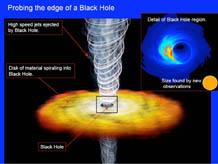
This illustration shows the extreme activity astronomers believe occurs near a supermassive black hole. Matter that is spiraling inward forms a disk swirling around the black hole, and high speed jets of energetic particles are ejected from the poles. The detail shows a computer simulation of the inner region where matter orbits just outside the black hole. The rotation of the disk surrounding the black hole causes one side to brighten. The size of this bright spot in the rotating disk is close to the size measured with the new observations.
Black holes are by far the "simplest" objects in the universe because they can be completely characterized by just three numbers: their mass, electric charge, and spin. Although they are simple - or perhaps because of it - they are remarkably mysterious, in part because they are impossible to see directly. They are irresistible sinks for matter and energy, surrounded by a zone (the "event horizon") within which anything that ventures will inevitably fall and disappear, even light. Despite their reputation for being pitiless devourers of matter and radiation, however, the environments of black holes are often sources of powerful radiation. Infalling matter can form a disk of material around the event horizon, and when these disks become hot from friction, they radiate copiously. Astronomers are trying to understand black holes because they are fundamental to our understanding of gravity, because they usually form in the final stages of a massive star's life, and because they are thought to be relatively common objects in the universe. Not least, very massive black holes are thought to reside at the centers of most galaxies, and to play a key role in the development of such galaxies.
The center of our Milky Way galaxy, about twenty-five thousand light-years from earth, harbors a four million solar-mass black hole whose environment emits very intense radiation. The event horizon of this black hole is calculated to be one-tenth of an astronomical unit in size, or four times smaller than the distance of the planet Mercury's orbit from the sun. If the bright radiation arises from near this event horizon, then effects of the powerful gravitational fields (so-called gravitational lensing) will make it appear to us as if it were coming from a larger region, about the size of Mercury's orbit.
A team of three SAO astronomers, Jonathan Weintroub, Jim Moran, and Ken Young, together with a team of twenty-five of their colleagues, has pioneered powerful (and very challenging) new technologies that coordinated the Submillimeter Array's (SMA) developments with other submillimeter and millimeter telescopes located in Hawaii, Arizona, and California to enable these telescopes to work together. By doing so, they were able to achieve dramatically improved resolution of the spatial images of the galactic center's black hole region. In fact, the new techniques enabled the system to image sizes as small as the expected, Mercury-orbit-sized event horizon (presuming it radiates with sufficient intensity at the millimeter wavelengths used in the observations).
Writing in last week's issue of Nature, the team reports that the measurements indicate that the radiation is coming from a region smaller than the putative event horizon, by about 30%. But that should be impossible, according to our current understanding, if it really does come from the edge of the event horizon. The implication is that for some as yet unknown reason the brightest portion of the radiation must instead be coming from somewhere else nearby. The team speculated that it could be arising in the flow of material that is accreting onto the disk. The results demonstrate the power of the new interferometric technology, open a new window on the mysterious environment of black holes, and mark the start of a new era probing even finer scale structures around these simplest of cosmic objects.